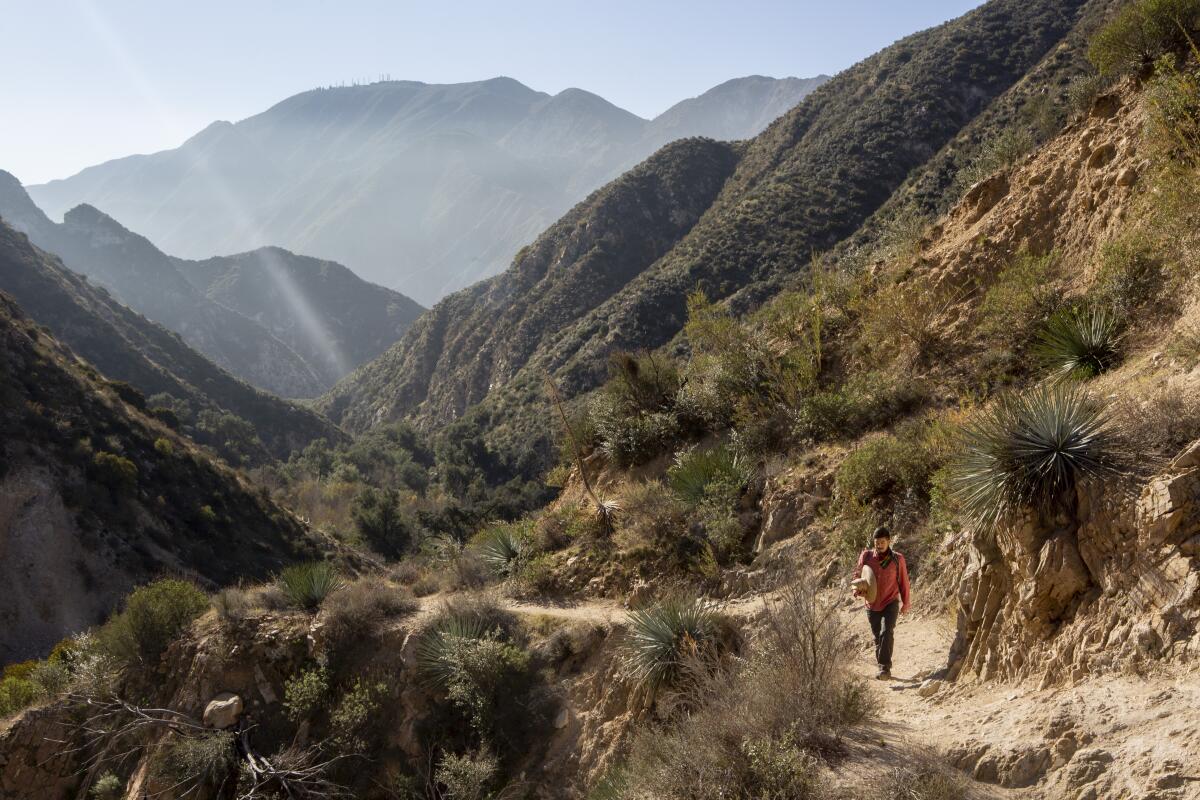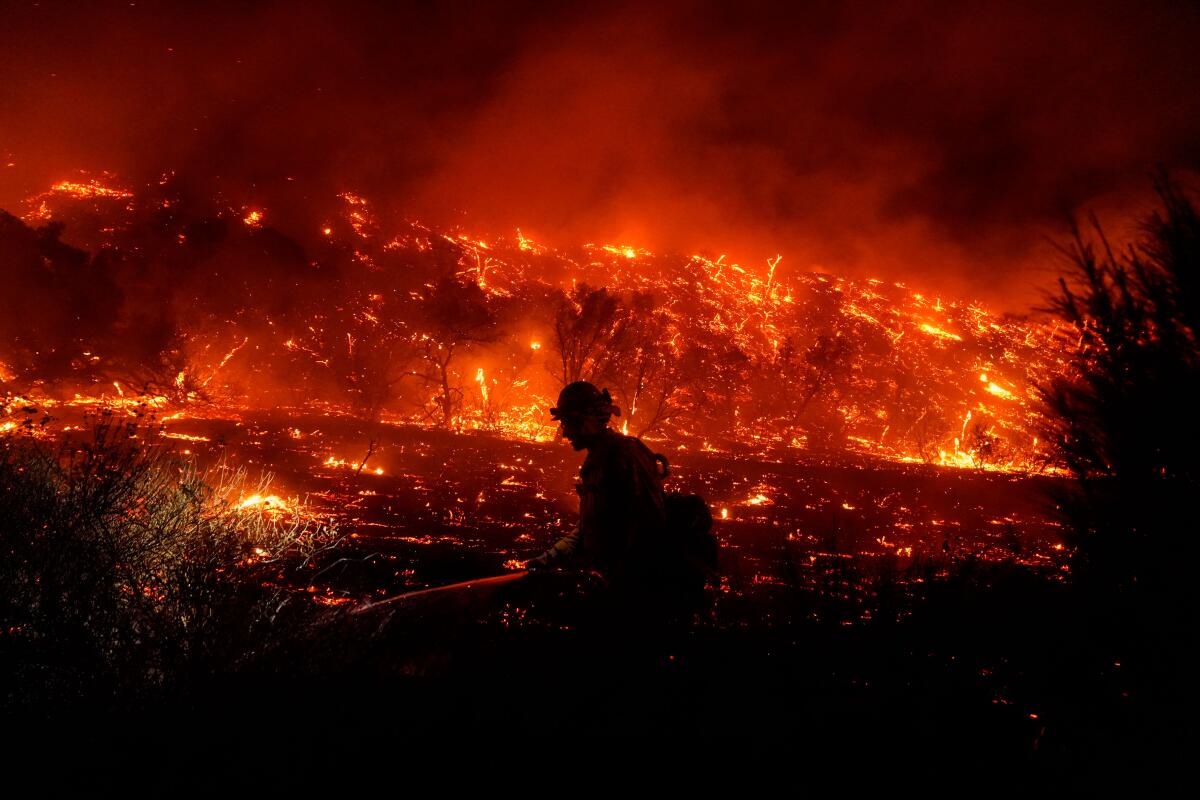Boiling Point: These wild lands in California and the West may soon get federal protection
This is the Dec. 10, 2020, edition of Boiling Point, a weekly newsletter about climate change and the environment in California and the American West.
More than 111 million acres of U.S. wilderness have been designated since 1964, when the Wilderness Act was signed by President Johnson. It’s the highest level of protection the federal government offers, ensuring that wild lands remain free of permanent roads, motor vehicles, commercial enterprise and structures of any kind.
The law’s definition of wilderness is the stuff of legend: “A wilderness, in contrast with those areas where man and his works dominate the landscape, is hereby recognized as an area where the earth and its community of life are untrammeled by man, where man himself is a visitor who does not remain.”
Pretty great, except for the whole “man” thing.
Back in February, the House of Representatives voted to protect more than 1.3 million acres of new wilderness and 1,000 miles of wild and scenic rivers in California, Colorado and Washington. A few months later, the House passed the same bill again, this time as an amendment to the National Defense Authorization Act.
Toward a more sustainable California
Get Boiling Point, our newsletter exploring climate change, energy and the environment, and become part of the conversation — and the solution.
You may occasionally receive promotional content from the Los Angeles Times.
Things were looking good for the Protecting America’s Wilderness Act until last week, when it was stripped from the final version of the defense bill, likely due to opposition in the Republican-controlled Senate. The legislation faced opposition from timber and fossil fuel interests and from the White House, which argued it could limit resource extraction.
But that’s not the end of the story. There are still legions of activists working to get the bill across the finish line. They’ll keep at it when the next Congress is seated in January, with an eye toward protecting 30% of U.S. lands and waters by 2030.
Here are the places that would be protected, from the mountains surrounding Los Angeles to the red cliffs of Colorado.
Rim of the Valley Corridor Preservation Act
The wilderness bill actually comprises six separate pieces of legislation. This one would more than double the size of Santa Monica Mountains National Recreation Area, adding 191,000 acres to a Los Angeles-area park that currently stretches from Griffith Park to Point Mugu and offers more than 500 miles of trails.
As a senior program manager at the National Parks Conservation Assn., Dennis Arguelles has spent years working to protect the “Rim of the Valley,” which basically encircles the San Fernando Valley. (Here’s a map.) The expanded recreation area would stitch together habitat traversed by mountain lions and create more opportunities to save threatened red-legged frogs.
Arguelles named Santa Susana Pass State Historic Park as one of his favorite spots on the Rim, describing chaparral-covered hillsides and stunning views of the valley. The Rim also includes a cornucopia of historic sites, including an ancient Native American water source, downtown L.A.’s Olvera Street and a ghost town that’s home to Southern California’s first commercial oil well.
“These places tell the story of the L.A. region and how it developed over the centuries,” Arguelles said.
Adding those places to Santa Monica Mountains National Recreation Area wouldn’t confer the strict protections of a wilderness designation. But it would allow the National Park Service, which manages the recreation area, to coordinate habitat restoration and protection across the interconnected landscape.
San Gabriel Mountains Foothills and Rivers Protection Act

For Belinda Faustinos, protecting the San Gabriel Mountains is important not only for wildlife and watersheds at the edges of L.A.’s suburban sprawl, but for the nearby communities that don’t have many opportunities to get outdoors.
Faustinos is executive director of Nature for All, a coalition whose members aren’t all typical environmental groups. They include COFEM, which is focused on immigrants’ rights, and API Forward Movement, which works on public health in Asian and Pacific Islander communities. Together, they work to connect people to public lands, in part through public transit.
“It’s not only about providing the access and opportunity to protect those mountains, but also improving the recreational amenities that help people get form one place to another,” Faustinos said — amenities such as bilingual signage.
This piece of the bill would add 109,000 acres to San Gabriel Mountains National Monument, designate 30,000 acres of wilderness and create a 50,000-acre national recreation area covering foothill areas and portions of the San Gabriel River, the Rio Hondo and the Puente Hills further south (Here’s a map.)
It would also designate 45 miles of San Gabriel River tributaries, as well as Little Rock Creek, as “wild and scenic rivers.” That’s a protection conferred by another federal law, also signed by President Johnson, designed to keep rivers free-flowing — in other words, no dams or disruptive new mining.
Central Coast Heritage Protection Act
We start moving north with this bill, which would designate 245,000 acres of wilderness and 159 miles of wild and scenic rivers in Los Padres National Forest and Carrizo Plain National Monument. (Map here.) California’s Central Coast features some of the most diverse habitats in North America, with wildlife ranging from endangered condors to tule elk and pronghorn antelope.
Rebecca August, advocacy director for Los Padres ForestWatch, described it as a region where the ecosystems of Southern and Northern California collide. It’s also a region coveted by fossil fuel companies. The Trump administration authorized the first oil well at Carrizo Plain, a breathtaking remnant of once-sprawling grasslands, since the areas was made a national monument.
This week, the Trump administration is also hosting the first oil and gas lease sale on federal lands in California since 2012. Some of the parcels up for auction are just outside the national monument.
In the national forest, logging is another concern. August pointed to a proposed forest thinning project at Pine Mountain, around a third of which is in areas that would be designated as wilderness under the bill.
“That’s an important component of this — to take these areas that don’t have roads, haven’t been mechanically disturbed, and make sure we don’t industrialize them,” August said. “They’ll be marred for generations and generations.”
Northwest California Wilderness, Recreation, and Working Forests Act
This bill would protect too many places for me to name them all. Here’s a document listing all 313,000 acres of proposed wilderness and 480 miles of wild and scenic rivers, courtesy of Ryan Henson, senior conservation director at the California Wilderness Coalition. And here’s an interactive map you can explore.
When I asked Henson to choose just one place for me to highlight, he settled on the proposed Chinquapin Wilderness, along the South Fork Trinity River in Shasta-Trinity National Forest. He described hiking mile after mile of shaded trail along a turquoise river that you can jump in on a hot day, and swim with salmon and steelhead.
He also said it’s probably the state’s largest swath of unlogged ancient forest not already protected. Locals have been fighting logging proposals since the 1960s. The wilderness area would be named for the chinquapin plant, typically a shrub that instead grows in tree form in this part of Northern California, sometimes over 100 feet tall.
“If you’re into botany, it’s heaven,” Henson said.
The bill would also require a feasibility study for the proposed Bigfoot National Recreation Trail, which would run 360 miles from Mendocino National Forest to the Pacific Ocean at Crescent City, briefly cutting through Oregon. Henson assured me that despite the name, “no one involved believes in Bigfoot.”
Colorado Wilderness Act
Conservationists in the Centennial State have been trying to get this bill passed for two decades, and they got closer than ever in 2020. It would designate 36 wilderness areas, covering 660,000 acres; here’s a list, and an interactive map.
“This would help protect what makes Colorado such a special state,” said Beau Kiklis, public lands advocate for Conservation Colorado. “People come here to spend time on our public lands.”
I asked him why these lands need permanent protection, and he pointed to a Trump administration “resource management plan” in Eastern Colorado that would open up huge amounts of land to oil and gas drilling, including areas along the Arkansas River, a tributary of the Mississippi. Joe Biden’s appointees could change course, but future administrations might have other ideas.
The proposed wilderness areas would protect several of Colorado’s beloved “fourteeners,” mountain peaks that reach higher than 14,000 feet. And they would secure access to nature for urban residents in the Denver area and elsewhere.
“We have an equity gap in terms of who does and doesn’t have access to nature,” Kiklis said. “In Colorado, people of color are 20% more likely to live in areas that have fewer opportunities to experience nature.”
Wild Olympics Wilderness and Wild and Scenic Rivers Act
And finally we reach the northwest tip of the Lower 48 states. This bill would designate 132,000 acres of wilderness within Olympic National Forest and 464 miles of wild and scenic rivers, protecting streams that flow from the snowmelt of Olympic National Park.
The rivers are critical for salmon and steelhead spawning, and the wilderness is beloved for hikes through old-growth forests and spectacular views of Puget Sound and the Cascade Volcanoes. That’s according to writer and conservationist Tim McNulty, who worries that the threats of logging and hydropower will never go away entirely until permanent protections are in place.
When I asked him for a favorite spot, he described a proposed wilderness area along the Dungeness River. On the other side of the Bailey Range, the rainforest gets 12 feet of rain a year. But in this “rain shadow,” the mountains limit precipitation to a mere 30 inches annually (which to me, a lifelong Southern California, still feels like a lot).
“This is a wet place up here,” McNulty said.
This summer offered “a fast-forward view of what the long-term future might look like,” McNulty said, as Seattle-area residents flocked to the Olympic Peninsula for hiking, camping and fishing in unprecedented numbers during the COVID-19 pandemic. As the urban population grows, he wants to ensure those wild places stay wild.
::
Here’s what else is happening around the West:
TOP STORIES
I wrote about the campaign for all-electric buildings in California, and the pushback from home builders and the gas industry. Here’s my story looking at the debate over whether state officials should ban gas hookups in new housing, a step Oakland, San Francisco, San Jose and other cities have already taken. Gov. Gavin Newsom recently promised “giant leaps forward” on fighting climate change, but his office declined to weigh in when I asked about mandating all-electric buildings.
Southern California has already had worse smog in 2020 than in any year since 1997, in terms of the number of bad air days for ozone pollution. More details here from The Times’ Tony Barboza, who writes that rising global temperatures are contributing to smog formation. Tony also notes that we’ve had 30 bad air days so far this year for fine-particle pollution, aka soot, a deadly pollutant that the Trump administration decided this week not to regulate more strictly, overruling its own scientists.
My colleague Rosanna Xia has one of those mind-blowing science stories that simultaneously depresses and impresses. She wrote about how scientists determined that mass coho salmon deaths up and down the West Coast are the result of ozone gas reacting with a preservative in car tires, producing a deadly toxin. Yes, car tires. The poisonous chemical has been washing off roads and flowing to the ocean whenever it rains, interfering with efforts to boost dwindling salmon populations.
Enjoying this newsletter? Consider subscribing to The Times
Your support helps us deliver the news that matters most, and makes newsletters like Boiling Point possible. Become a Los Angeles Times subscriber.
THE ENERGY TRANSITION

The Trump administration plans to lease land for oil and gas drilling in California for the first time since 2012. The auction is scheduled for Thursday morning, a few hours after this newsletter sends. But the Biden administration may be able to cancel any leases, and even if that doesn’t happen, legal challenges are a near-certainty, my colleague Anna M. Phillips reports.
Why is the recycling industry struggling so badly? Changing waste streams due to the pandemic are a big reason, but so are low oil and gas prices, which have made newly created “virgin” plastic super cheap to produce, The Times’ Megan Calfas reports.
The electric car industry is poised for massive growth, but it’s not yet clear which companies will come out on top. Our auto reporter, Russ Mitchell, is a fan of Volkswagen’s new ID.4, calling it “the first true mainstream electric car for sale in the U.S.” in a review this week. Russ also wrote about Porsche’s plan to use wind power from Chile to make a carbon-neutral fuel to power its sports cars. Tesla, meanwhile, is being sued for defamation by a former employee who says she was pressured into resigning after raising safety concerns to Chief Executive Elon Musk. The company accused her of criminal behavior, Russ reports.
AROUND THE WEST
There’s nothing more western than a battle over land, and I’ve got two for you this week. The Times’ Louis Sahagun reports that Tejon Ranch Co. — which owns the state’s largest single piece of private property, an hour’s drive north of Los Angeles — is withholding promised conservation funding based on a disputed claim that environmentalists haven’t held up their end of a deal with the landowner. Meanwhile, to the south, the San Diego Union-Tribune’s Joshua Emerson Smith reports that state officials rejected a proposal that would have allowed a sprawling new development on an ecological reserve in San Diego County.
Nevada released its first comprehensive climate strategy, an early roadmap to the goal of net-zero emissions by 2050 that scientists say the world must achieve. The plan includes a call to transition away from gas for heating, cooking and electricity, as Daniel Rothberg reports for the Nevada Independent, mirroring the debate I’ve been writing about in California.
As the West gets drier, farmers and ranchers have a key role to play in sustainable water use. That’s especially true in the Colorado River Basin, where agricultural landowners tend to control the biggest and oldest water rights but frequently face pressure from cities to sell. Politico’s Annie Snider wrote an excellent deep dive about Paul Bruchez, a Colorado rancher working to develop innovative strategies for protecting agricultural economies while ensuring urban areas have enough water. We may need some short-term solutions, too; as my colleague Paul Duginski reports, the latest western drought map does not look good.
CALIFORNIA BURNING

December brought still more fires to Southern California. In Orange County’s canyon country, the fast-moving Bond fire prompted evacuation orders for 25,000 people and caused another round of especially poor air quality. In Ventura County, a tree toppling onto a Southern California Edison power line was the likely cause of a small blaze, even as the company shut off power to more than 50,000 customers to try to prevent ignitions. It was Edison’s second such shutoff in a week. The Times’ Hayley Smith — who wrote all those stories, by the way, with an assist in one case from Stephanie Lai — now reports that lower temperatures and moister air are finally giving us a brief break from dangerous fire weather, although there’s still no rain in the forecast.
“The Santa Cruz Mountains, with their steep terrain and history of drenching storms, were burned so badly and extensively that the lattice of roots and foliage that typically holds the ground in place is gone.” Such was the destruction wrought by the CZU August Lightning Complex fire, and now mudslides are coming, my colleague Susanne Rust reports.
If you live in or around the burn scar of the Bobcat fire, you won’t lose your home insurance — at least for now. Joseph Serna reports that state officials have expanded a moratorium on insurers dropping policies to include hundreds of thousands of people affected by the Bobcat fire, which tore through Angeles National Forest. The moratorium lasts through Sept. 25, 2021.
ONE MORE THING
“Water is joining gold, oil and other commodities traded on Wall Street.” So writes Bloomberg’s Kim Chipman, who explains that investors can now bet on water scarcity in California.
You can spare me the “Mad Max” GIFs — I already got plenty of them when I tweeted this story.
We’ll be back in your inbox next week. If you enjoyed this newsletter, please consider forwarding it to your friends and colleagues.




